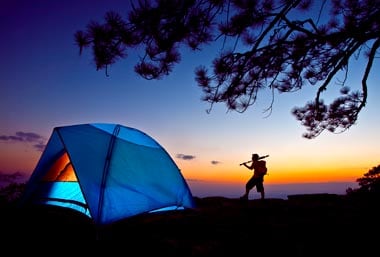What is Camping

Camping is a recreational (and oftentimes laid-back) activity pursued outdoors, away from cities and towns and in the lap of nature, with fresh air and (occasionally) wildlife for company. One can set up a tent, or live in a caravan, camper-van or motor-home when camping. But the classic camping trip involves toughing it out in tents – and at the mercy of Mother Nature.
Camping can be – and usually is – combined with other adventure activities, such as hiking/trekking, fishing, whitewater rafting and kayaking, giving one the ultimate outdoors experience. It can be an individual pursuit, but is often done in the company of friends and family. It’s a pastime that can be enjoyed by the young and the old. Camping is also a convenient option for those attending music festivals or sports gatherings. While camping has moved on from its rough-and-ready, back-to-nature origins, hardy folks are still willing to rough it out in the wilderness, no matter how conspiratorial the elements might be. But for families, with kids in tow, camping is the perfect activity for a vacation.
History of Camping
Tents have been used for centuries – by Native Americans (wigwams), by Mongolian and Central Asian nomads (yurts), and by armies moving from battleground to battleground.
As a pastime, camping took off in popularity in the British Isles towards the end of the 19th century, as the Victorian era drew to a close. A fellow by the name of Thomas Hiram Holding, who was the author of the first known camper’s handbook (1908), which detailed the essentials of camping, is regarded as the father of modern recreational camping. Holding, an itinerant tailor by profession, was one of the movers behind the Camping and Caravanning Club – among those who have acted as head of the club are Captain Robert Falcon-Scott (‘Scott of the Antarctic’) and Robert Baden-Powell, founder of the scouting movement. Holding’s experiences in the outdoors included crossing the prairies of the US in a wagon train as a young boy, camping with a canoe in the Highlands of Scotland, and camping with a bicycle in the northwest of Ireland.
While people took to communing with nature, and sleeping out under the stars, as a means of escape from the stresses of city life, they still had to contend with the elements. Here, caravans came to the rescue, and caravanning as an offshoot of camping became popular in the 1930s. In the USA, camping became an organized activity post the Second World War, as Americans became more mobile and sought new leisure options.
Youth groups like the Boy Scouts and Girl Guides incorporate the activity as part of inculcating the virtues and values of teamwork and self-reliance – through camping, one learns how to survive in the wilds.
Camping in India
Camping and campers form much less of the landscape in India than they do in places like Europe, the US and Australia. But there is, nevertheless, a dedicated, enthusiastic and growing bunch of campers who are looking to make the most of India’s natural beauty by setting up camp in out-of-the-way places, as far away from civilization as possible. Indeed, India has plenty of beauty spots for the happy camper – and the adventurous one.
What you won’t come across in India are commercial campsites, teeming with vacationing folk (this is common in Britain); because camping is (still) the hobby of a few, ‘campsites’ here are likely to be solitary and quiet locations. Camping in India, then, is still done wild, without the amenities and comforts of modern campsites – which really is the best way to experience this very outdoorsy pastime.
Deserts, beaches and even national parks (Gir and Bandhavgarh, for example) make for splendid camping destinations.
Know more about popular options for Camping in India.
Equipment
Tent, torch/flashlight/lantern, sleeping bag, lockable duffel bag (recommended), Therm-a-Rest/air mattress, Swiss Army knife, stove, whistle, lighter, hammer/mallet (to drive tent stakes into the ground), axe/saw/hatchet (for chopping firewood for campfire), ropes, tarpaulin (to protect against rain), food storage, cooler (to store drinks and fresh produce)
Best season in India
It’s unadvisable to camp out in the open in bone-chilling cold or enervating heat (unless you’re an extreme adventurer!). That leaves the rest of the year, plenty of time to plan a camping trip. The months of spring and autumn are the ideal, while both early summer and early winter offer delightful conditions for a bit of outdoors relaxation (or adventure!).
Camping sites in India
NORTH
Ladakh – Nubra Valley, Pangong Tso
Himachal Pradesh – Chandratal Lake, Kaza (Spiti Valley), Sarchu (Lahaul), Sangla, Kalpa (Kinnaur), Solang Valley (Manali), Dharamsala
Uttarakhand – Chitrauli (Nainital), Chamba (Garhwal), Kumaon, Mussoorie, Rishikesh, Chilla, Kaudiyala, Corbett National Park
Jammu and Kashmir – Sonamarg
CENTRAL
Rajasthan – Jaisalmer, Pushkar
SOUTH
Goa – Anjuna
Tips
Out in the open, you’ll come across denizens of the wilderness who might think you’re trespassing on their territory, so do maintain a respectful distance. Come well prepared (see equipment), and ready for any emergency. Nature, in the form of the animal kingdom and the weather, does tend to spring some nasty surprises, so make sure you have your wits about you. And come equipped with bucketloads of patience!
Medical concerns
Bring a first-aid kit and insect repellant, along with some sunscreen and sanitizer. Don’t forget to pack rations you might need in an emergency.
Ecological concerns
Campers are fortunate to have the sky as a roof, and the earth as a floor – don’t take your environs for granted. Since camping is, by and large, pursued outdoors, it is important to not disturb the inhabitants of the area, and their habitats. When setting up camp, be ecologically sensitive to your immediate surroundings, intruding as little as possible on the flora and fauna of the area. And do not litter – bring trash bags to dispose of all rubbish.







 Share Via
Share Via















